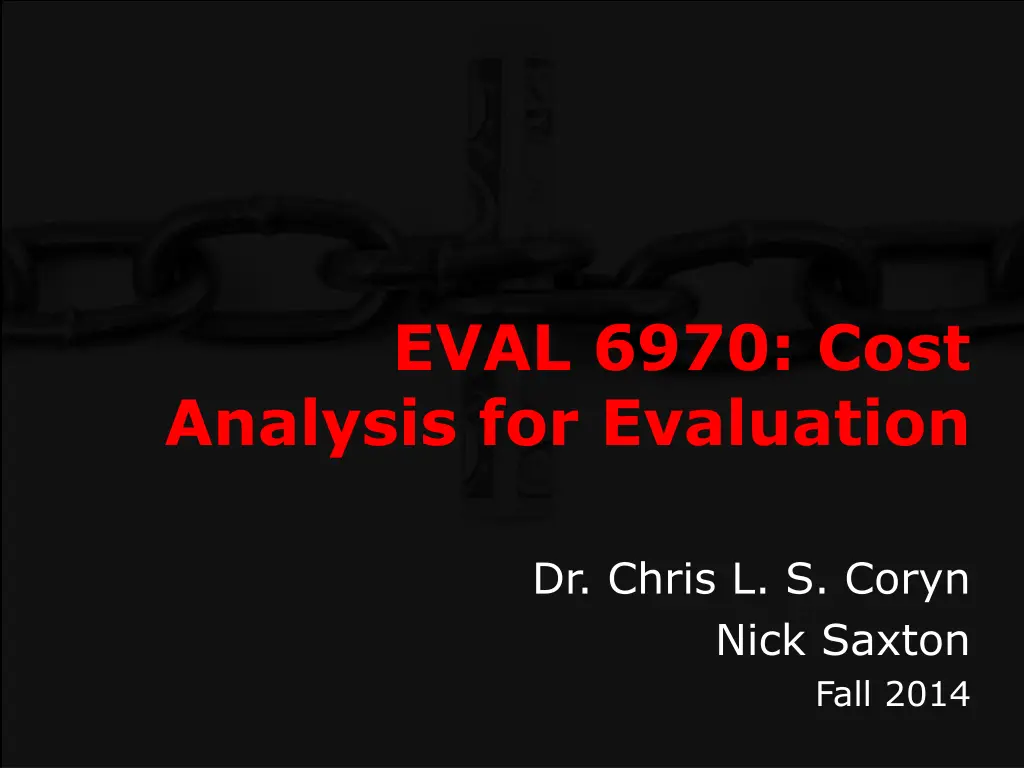
Understanding Cost Analysis and Valuing Benefits in Evaluation
Explore the concepts of cost-benefit analysis, methods of valuing benefits, and analyzing the distribution of benefits in evaluation processes. Learn about discounting benefits and the importance of considering all relevant constituencies when monetizing benefits.
Download Presentation

Please find below an Image/Link to download the presentation.
The content on the website is provided AS IS for your information and personal use only. It may not be sold, licensed, or shared on other websites without obtaining consent from the author. If you encounter any issues during the download, it is possible that the publisher has removed the file from their server.
You are allowed to download the files provided on this website for personal or commercial use, subject to the condition that they are used lawfully. All files are the property of their respective owners.
The content on the website is provided AS IS for your information and personal use only. It may not be sold, licensed, or shared on other websites without obtaining consent from the author.
E N D
Presentation Transcript
EVAL 6970: Cost Analysis for Evaluation Dr. Chris L. S. Coryn Nick Saxton Fall 2014
Agenda Cost-benefit analysis Activity
What is the value of a graduate education?
The concept of benefits Many, but not all, benefits can be expressed in monetary units (e.g., lifetime earnings) Maximum willingness-to-pay (WTP) is one means for expressing benefits in monetary units though subject to many validity concerns When monetizing benefits, benefits for all relevant constituencies should be considered
Methods of valuing benefits 1. Estimate benefits from experimental, quasi-experimental, or correlational designs (relative to alternatives/controls) 2. Estimate benefits using contingent valuation (surveys designed to elicit WTP) 3. Observed behavior (based on actual economic decisions rather than reported WTP)
Benefits (+) and Costs (-) From the Perspective of Program Participants Other Members of Society Total Benefits Earnings gained + 0 + Reduced costs of nonexperimental services 0 + + Transfers Reduced welfare benefits - + 0 Wage subsidies + - 0 Costs Operational program costs 0 - - Forgone leisure and home production - 0 - Net benefits +/- +/- +/-
Discounting benefits Premised on the same rationale as that used for cost-effectiveness analysis Essentially, early investments accrue greater financial benefits than later investments Money invested earlier is of greater value than money invested later
Analyzing the distribution of benefits As with cost-effectiveness analysis, benefits should be (if appropriate) disaggregated over relevant subgroups If necessary and appropriate, benefit-cost ratios should be estimated (1) overall and (2) for each subgroup
Combining costs and benefits Compare the benefits of each alternative to its associated costs Nearly always requires discounting as benefits and costs occur over time (the sum of discounted benefits and discounted costs) I prefer using the benefit-cost ratio (BCR) and net benefits (NB) methods to the internal rate of return (IRR), which has many practical limitations
The formula for discounting benefits (B) and costs (C) are presented on page 176
Benefits Costs Year 1 $0 $300 Year 2 $150 $0 Year 3 $150 $0 Year 4 $150 $0 Year 5 $150 $0 Here, assuming a discount rate of 5%, the discounted sum of benefits = $531.89 (see formula, calculations, and example on page 176) Costs, however, are not discounted as they occur only in the first year and = $300
Note that discounting is not necessary in the first year, or instance, of estimating either costs or benefits as one part of the term in the denominator is always = 0 (therefore, use the actual costs and actual benefits) This will be important in the Exercise later
From these data, the benefit-cost ratio (BCR) is: BCR = B/C or BCR = $531.89/$300.00 = $1.77
Expressed as net benefits (NB), the sum of benefits are: NB = B - C or NB = $531.89 - $300.00 = $251.89
Download the Excel file Cost-Benefit Data Set from the course website Estimate the benefit (B), cost (C), benefit-cost ratio (BCR), and net benefit (NB), for each alternative using discount rates of 3%, 5%, and 10% Interpret the results






















